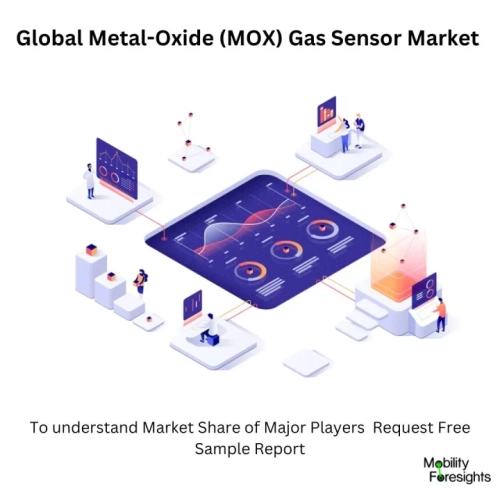
- Get in Touch with Us

Last Updated: Apr 25, 2025 | Study Period: 2024-2030
The Metal-Oxide (MOX) Gas Sensor Market is witnessing significant growth globally, driven by increasing concerns regarding air quality, industrial safety regulations, and the rising demand for environmental monitoring solutions. MOX gas sensors are widely utilized for detecting various gases such as carbon monoxide, methane, nitrogen dioxide, and volatile organic compounds (VOCs) across diverse applications including automotive, industrial, environmental, and consumer electronics sectors.

With ongoing technological advancements, such as the development of miniaturized sensors, integration of artificial intelligence (AI) and internet of things (IoT) capabilities, and the emergence of wearable and portable sensor devices, the MOX gas sensor market is poised for further expansion and innovation.
However, the market faces challenges related to calibration issues, cross-sensitivity to different gases, and limited detection accuracy at low gas concentrations. Despite these challenges, increasing investments in research and development activities, growing adoption of smart city initiatives, and stringent regulatory mandates for workplace and environmental safety are expected to drive sustained growth in the MOX gas sensor market.
Regional variations in regulatory frameworks, industrialization levels, and environmental concerns also influence market dynamics, with Asia Pacific emerging as a prominent region for market expansion due to rapid urbanization, industrialization, and government initiatives towards pollution control and emission monitoring.
The Metal-Oxide (MOX) Gas Sensor Market is a dynamic sector within the sensor industry, characterized by the increasing demand for accurate and reliable gas detection solutions across various applications such as environmental monitoring, industrial safety, automotive, healthcare, and smart cities.
MOX gas sensors utilize metal-oxide semiconductor materials to detect the presence of specific gases by measuring changes in electrical conductivity. With advancements in sensor technology, including miniaturization, improved sensitivity, and lower power consumption, MOX gas sensors are becoming integral components in gas detection systems for diverse industries.
Rising concerns regarding air quality, workplace safety regulations, and the need for real-time monitoring solutions are driving the adoption of MOX gas sensors, presenting significant opportunities for market players to innovate and expand their product offerings.

The Metal-Oxide(MOX) Gas Sensor market is estimated to be worth $ XX billion by 2030, and is expected to grow at a compound annual growth rate (CAGR) of YY%. Another report projects that the market will reach $XX billion by 2030, growing at a CAGR of YY% from 2024 to 2030.
In recent years, the Metal-Oxide (MOX) Gas Sensor market has witnessed notable trends that are reshaping its landscape. One significant trend is the increasing adoption of MOX gas sensors across diverse industries such as automotive, industrial manufacturing, healthcare, and environmental monitoring.
This adoption is driven by the sensors' ability to detect a wide range of gases with high sensitivity, accuracy, and reliability, making them essential for applications like air quality monitoring, leak detection, and safety systems. Additionally, advancements in nanotechnology and material science have led to the development of next-generation MOX gas sensors with improved performance characteristics, including faster response times, lower power consumption, and enhanced selectivity.
Another notable trend is the integration of MOX gas sensors into Internet of Things (IoT) and smart devices, enabling remote monitoring, real-time data analytics, and predictive maintenance capabilities. This integration enhances operational efficiency, safety, and environmental compliance across various sectors.
Furthermore, increasing regulatory mandates and standards pertaining to emissions control, workplace safety, and indoor air quality are driving the demand for MOX gas sensors, as companies seek to ensure compliance and mitigate risks. Moreover, rising awareness about the importance of environmental sustainability and health concerns related to air pollution are further fueling the market growth for MOX gas sensors.
Overall, these trends indicate a promising outlook for the Metal-Oxide Gas Sensor market, with continued innovation and expansion into new application areas expected to drive further growth in the foreseeable future.
Market Segmentation of Metal-Oxide (MOX) Gas Sensor:
By Application:
By End-Use Industry:
By Type:
By Technology:
Geographic Segmentation:
| Sl no | Topic |
| 1 | Market Segmentation |
| 2 | Scope of the report |
| 3 | Research Methodology |
| 4 | Executive Summary |
| 5 | Introduction |
| 6 | 5 Key Predictions for Metal-Oxide(MOX) Gas Sensor Market |
| 7 | Insights from Industry stakeholders |
| 8 | Cost breakdown of Product by sub-components and average profit margin |
| 9 | Average B-2-B selling price in past 5 years |
| 10 | New product development in past 12 months |
| 11 | Expansion and Applications of the Metal-Oxide(MOX) Gas Sensor |
| 12 | Importance of Technological innovation |
| 13 | Impact Thermal Storage Systems and Smart Grid Integration |
| 14 | Market Size, Dynamics and Forecast by Application , 2024-2030 |
| 15 | Market Size, Dynamics and Forecast by End-use industry, 2024-2030 |
| 16 | Market Size, Dynamics and Forecast by Type, 2024-2030 |
| 17 | Market Size, Dynamics and Forecast by Geography, 2024-2030 |
| 18 | Market Size, Dynamics and Forecast by Technology, 2024-2030 |
| 19 | Competitive Landscape |
| 20 | Gross margin and average profitability of suppliers |
| 21 | M&A in past 12 months |
| 22 | Growth strategy of leading players |
| 23 | Market share of vendors, |
| 24 | Company Profiles |
| 25 | Unmet needs and opportunity for new suppliers |
| 26 | Conclusion |